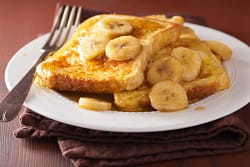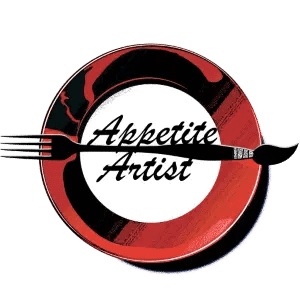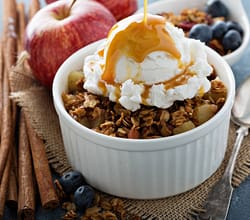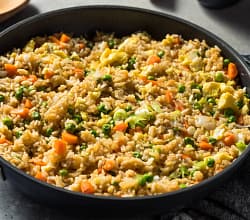When I was a kid, I always loved buying those cinnamon French toaster sticks, microwaving them for about a minute, then preparing a little cup with syrup so that I could dip the sticks in them. It brought a smile to my face whenever I took a moist, syrup-coated bite first thing in the morning. It wasn’t exactly homemade or healthy French toast, but it was cheap and delicious, so who cares, right?
As an adult, however, I tried experimenting with building my own French toast from scratch, and I can say for sure that it is the best way to go if you are a French toast fan. You are in control of how much powdered sugar and syrup you use, and most importantly, which type of bread you use. Similar to homemade pancakes, you can add a lot a variety and versatility to your French toast, during and after the cooking process. Once you go homemade French toast, you’ll never want to go back to store-bought toast.

French toast is simply a serving of sliced bread, soaked in a beaten egg and milk mixture, and cooked on a skillet to enhance its taste and texture. It has gained a reputation as a popular breakfast dish, and almost every single breakfast restaurant sells it. Depending on what bread you use, your healthy French toast can be either a delightful breakfast concoction or a sloppy, soggy mess. With this in mind, it is important to have the knowledge of what types of bread work best.
Why make healthy French toast from scratch at home?
Retail French Toast
Store-bought French toast can be unhealthy for a lot of reasons. In the US, for example, premade French toast can contain unhealthy sugars in the form of high fructose corn syrup (HFCS). This sweetener is a genetically modified, cheaply made form of corn syrup that feels good on the tongue. The majority of HF corn syrup’s content is fructose (55% composition), which is a sugar type that requires more work from the body to break down and digest.
Foods containing HFCS can also contain other unhealthy additives and preservatives such as maltodextrin and monosodium glutamate (MSG). I would strongly suggest you stay away from store-bought French toast if they contain these ingredients, especially from retailers like Target and Walmart. There has been a strong link between ingredients found in processed foods and long-term cancer formation from consuming them (courtesy of the NIH).
If you decide to buy your French toast from retailers, buy it from companies that do not allow artificial additives and preservatives in their food. Ultimately, you are responsible for looking at the ingredients and doing your own research.
Homemade French Toast
Making French toast from scratch is the best way to go if you want your toast to be healthier. You directly control what type of bread you use and what you put inside and outside of it. Not only can you infuse eggs into your toast through pan-frying, but it will also be less calorie-dense, too.
If you opt for whole-grain or multi-grain varieties of bread, you will also get a decent amount of fiber and essential vitamins and minerals. Don’t forget also that you can add foods like fresh fruit, honey, and nuts/seeds for better nutritional value and taste.
Cooking food is a skill, and making your own French toast from home enhances that skill. The quality of your homemade French toast is dependent on how well you can control the temperature of your stove and what you put in your egg mixture, not to mention that these variables are affected by what type of bread you use. French toast is a highly experimental food and I love cooking it.
Which bread to use to make healthy French toast
There are lots of bread types to choose from when making French toast, but only a few of them will make your toast taste high-quality. Theoretically, you can choose any bread type you wish, but many will not be strong enough to withstand moisture. There are three in particular that prove most consistent and reliable when making great French toast.
All three of these breads are dense and sturdy, allowing them to absorb egg moisture quite easily. They are also good in the post-cooking phase whenever you want to dip them in syrup or retain the flavor of powdered cinnamon.
Brioche

Brioche is a French pastry that sports a high content of egg and butter. This gives it a rich and tender taste and texture. Without a doubt, brioche French toast is the definitive food that gets the family swarming around the table during breakfast.
The bread is very durable during fry cooking and the French toast that is made with it can be served with a variety of toppings. These toppings include maple syrup, fresh fruit, icing, powdered sugar, and whipped cream. Brioche is a reliable standard for healthy French toast and is a great beginner-friendly bread to start with.
Challah

Challah is remarkably similar to brioche, but with one key difference. Its unique bread dough is enriched with oil instead of butter, so the texture and flavor of it will feel somewhat different from brioche. Arguably, challah is a heathier alternative to brioche when making healthy French toast.
However, challah bread is typically braided before baking, so when you cut individual slices, the shape of your slices may be inconsistent. The braiding helps keep its texture and durability stable. Challah is one of the few bread types that has an irregular shape compared to other breads, which usually come in a square-like shape. Still, challah is an excellent bread to use for a delicious and filling French toast.
Sourdough

Sourdough is a uniquely valuable bread type. It may not be as rich as brioche or challah, but it has a sturdy outside shell and a soft interior, making it a great choice for French toast. Additionally, it keeps its shape well, soaks easily in egg custard, and can even be prepped in advance for overnight French toast casserole. Unlike most other bread types, sourdough is the only “hard” bread type that works well for French toast.
Sourdough has the unfair advantage of being cheap and easy to find, but still very delicious. It is the most common French toast bread, seen in restaurants and homes alike. If you have leftover sourdough bread or want to use the last vestiges of a loaf, don’t be afraid to use sourdough bread for your healthy French toast. Usually, we throw out bread that is close to expiring because it starts to get hard and stale, but for sourdough, you can transform it into a soft and tasty breakfast.
Finally, with no added sugars, sourdough plays the role of a low-sugar bread option. Unlike challah and brioche, sourdough bread usually does not contain additional sugars, which gives it a less sweet taste. The lack of richness and sponginess on the outside is the reason why I personally prefer the other two breads over sourdough.
Healthy French toast ingredients
French toast has a few essential ingredients that are required in the recipe.
- Sliced bread (thick-cut). Brioche, sourdough, and challah are great breads to use. They are sturdy and able to hold their weight while also being spongy and mouthwatering. For the best results, try to cut your bread slices about one inch thick.
- Eggs. Used for coating your French toast during pan-frying.
- Milk. Any milk, dairy or non-dairy, will work. They combine with the eggs to make a creamy egg mixture (similar to scrambled egg mixture). I like to use buttermilk, since it adds flavor and richness to the bread.
- Cinnamon. The perfect French toast coating. Enough said.
- Coconut oil/margarine. Choose one of these two healthy fats during pan-frying.
Alternative non-essential ingredients and toppings
These ingredients aren’t mandatory, but they can make your healthy French toast taste like a top-tier gourmet food.
- Maple syrup
- Powdered sugar
- Orange or apple juice to mix with the egg mixture
- Vanilla extract for flavor
- Almond extract for flavor
- Nutmeg for flavor
- Pumpkin spice for flavor
- Fruit purees
- Small berries like strawberries and blueberries

Healthy Homemade French Toast
Equipment
- 1 medium bowl
- 1 large skillet
- 1 kitchen tongs for gripping the bread
Ingredients
- 4 slices 1" thick bread brioche, challah, or sourdough
- 2 large eggs
- ¾ cup milk dairy or non-dairy
- 1 tbsp coconut oil/margarine
- 1 tsp vanilla extract
- 1 tsp almond extract
- 1 tsp cinnamon
- ¼ tsp nutmeg
- maple syrup post-cooking topping
Instructions
- Combine the eggs, milk, extracts, nutmeg and cinnamon together in a large bowl. Additional liquids such as juice must also be added during this step.
- Once fully combined, separate the mixture into two bowls, each containing half of the total amount.
- Soak your bread slices into the mixtures, preferably one at a time. Soak both sides of the bread for two minutes to ensure they are fully immersed.
- Heat a skillet on medium heat over a stove. Add your chosen fat (coconut oil/margarine) to the skillet and put in one or two bread slices, depending on your skillet size.
- Cook both sides of your bread until they become golden-brown and toasty. This usually takes around 3 minutes per side. I like to use tongs to flip the bread over. You may also sprinkle additional cinnamon on each side if you prefer. Once ready, serve onto a dish.
- Repeat the previous two steps until all your slices are cooked thoroughly.
- Serve with maple syrup, powdered sugar, fruit puree, or whatever else you wish. They can also be cut into sticks and dipped into a cup of syrup to make French toast sticks. Enjoy!






